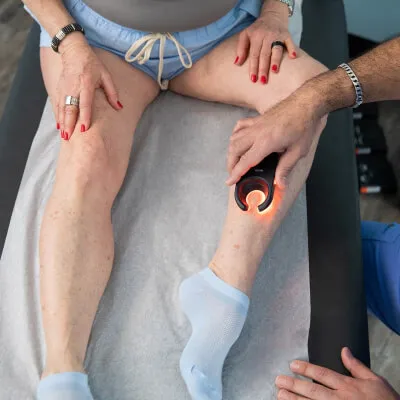You might not be familiar with deep vein thrombosis (DVT), but it's a condition worth learning about, especially your individual risk factors. DVT has impacted many people and, as seen with professional athletes like former NBA player Chris Bosh and former NFL player Billy Price, can even have career-ending consequences.
DVT occurs when blood clots form in deep veins, often in the legs, and can lead to serious complications like pulmonary embolism (PE). While it's a risk for everyone, emerging research highlights that men and athletes face a slightly higher chance of developing this life-threatening condition. Let's explore some of the reasons why vein experts think that men and professional athletes are more at risk.
The Gender Gap: Why Men Are More Vulnerable
Studies indicate that men are slightly more likely than women to experience DVT and its potentially life-threatening consequence, PE, particularly after an initial blood clot. An additional concern is that when men do develop DVT, it tends to be more severe, often affecting larger veins closer to the body's core (proximal DVT).
While the exact reasons are not completely clear, there are several factors linked to male characteristics that appear to play a role:
- Height: Interestingly, being taller has been correlated with a higher DVT risk. The longer veins in taller individuals might present a greater surface area for clots to form.
- Male Hormones: Research suggests a potential link between male hormones (testosterone) and an increased likelihood of blood clot formation. However, reasons for this correlation are still being explored.
- Medication Compliance: A less discussed but potentially significant factor is medication adherence. Some studies have indicated that men are less consistent in taking anticoagulants, which are prescribed to prevent recurrent blood clots.

Other Risk Factors
The well-established Wells clinical pretest score, used to assess the probability of a patient developing DVT, remains a helpful diagnostic tool for identifying high-risk individuals regardless of gender. It's important to remember that DVT doesn't discriminate, and both men and women share several common risk factors for developing DVT. These include:
- Prolonged inactivity
- A history of injuries or surgeries
- Obesity
- Smoking
- A family history of blood clots
- Use of certain medications
- Specific chronic medical conditions

Athletes and Increased Risk
Although you would think the opposite would be true, athletes face an elevated risk of DVT. Several factors are thought to contribute to this trend:
- Frequent Air Travel: The demanding schedules of many professional athletes often involve frequent and long flights. Prolonged sitting with limited mobility during air travel is a well-known risk factor for DVT.
- Repeated NSAID Use: Athletes frequently rely on non-steroidal anti-inflammatory drugs (NSAIDs) like Advil to manage pain and inflammation from intense training and competition. Some studies suggest a potential link between NSAID use and an increased risk of blood clots.
- Repetitive Motions and Trauma: The repetitive and often high-impact nature of many sports can lead to subtle or significant trauma and bruising, potentially damaging blood vessels and increasing the risk of clot formation.
- Exertion and Dehydration: Intense physical activity can lead to dehydration, which can thicken the blood and make it more prone to clotting.
- Specific Sport Risks: Data from 1999 to 2016 reveals the number of DVT events across various professional sports leagues in North America: NHL (22 events), MLB (16 events), NFL (12 events), and NBA (5 events). This highlights that athletes across different disciplines are susceptible.
Professional Athletes Who Have Suffered a DVT
Several high-profile professional athletes have been in the news after suffering from a DVT. NBA players Damian Lillard, age 34, and Victor Wembanyama, age 21, were both recently diagnosed with the condition within a few months of one other.
Lillard suffered a DVT in his calf and does not know when he will be able to return to play for the Milwaukee Bucks. According to NBA reporter Chris Haynes on the social media platform X, Lillard said this about his health scare, "It's unfortunate that something outside of my control would come up. Along with the Bucks' medical staff, our priorities are to protect my health and safety. As much as I love basketball, I need to be there for my kids and my family."
Wembanyama, who plays for the San Antonio Spurs, was diagnosed with a DVT in his right shoulder, and will not be returning to the game for the remainder of the 2024-2025 season.
Other well-known athletes that have experienced a DVT during their professional careers include tennis player Serena Williams and NHL players Steven Stamkos and Frederik Andersen. Andersen, who was diagnosed with a DVT and eventually a pulmonary embolism, described some of the warning signs he experienced saying, "I was dealing with some pain low in the lungs, and that's what kind of hindered me breathing...It was a minimum of three months on a heavy dose of blood thinners." Andersen was able to return to the game after several months of treatment.
Awareness and Prevention: A Winning Strategy
Understanding the heightened risk of DVT in men and athletes is the first step towards prevention. While some risk factors like height are unavoidable, others can be managed through lifestyle modifications and proactive measures.
For both men and women, staying active, maintaining a healthy weight, avoiding smoking, and being aware of family history are of equal importance. Athletes, in particular, should prioritize staying well-hydrated, managing injuries, and being mindful of the potential risks associated with frequent air travel and NSAID use.
If you experience symptoms of DVT, such as pain, swelling, redness, or warmth in your leg, seek immediate medical attention. Early diagnosis and treatment are crucial in preventing serious complications.

Conclusion
While the reasons behind the increased DVT risk in men and athletes are still being explored, awareness and proactive management are our strongest defenses against this potentially dangerous condition. By understanding the risks, we can all take steps to stay healthy and active.
Take control of your vein health today by scheduling a free vein health evaluation at Metro Vein Centers. Our expert team can assess your individual risk factors and provide personalized recommendations for prevention and vein health management.
Frequently Asked Questions
What are the main symptoms of DVT?
Common symptoms include pain, swelling, redness, and warmth in the affected leg. However, DVT can sometimes occur without noticeable symptoms.
Who is at risk for DVT?
While men and athletes have a higher risk, other factors like prolonged inactivity, surgery, obesity, smoking, family history, and certain medications can increase anyone's risk.
Can DVT be prevented?
Yes, in many cases. Staying active, maintaining a healthy weight, avoiding smoking, staying hydrated (especially for athletes), and adhering to prescribed medications can help reduce the risk.
Why is frequent air travel a risk factor for DVT?
Prolonged sitting with limited movement during flights can slow blood flow in the legs, increasing the risk of clot formation.
Are blood clots in athletes always serious?
Yes, any blood clot, including DVT, can be serious as it carries the risk of traveling to the lungs and causing a pulmonary embolism (PE), which can be life-threatening.
What does a vein health evaluation involve?
A vein health evaluation typically involves a review of your medical history, a physical examination of your legs, and potentially a non-invasive ultrasound to assess blood flow in your veins.
How is DVT treated?
DVT is typically treated with anticoagulant medications (blood thinners) to prevent the clot from growing and reduce the risk of PE. In some cases, other treatments like compression stockings or clot-dissolving medications may be used.

Dr. Jason Cumbers
Meet Dr. Jason Cumbers, MD, FACS, DABVS, RPVI, a highly-rated doctor specializing in the treatment of vein conditions. Schedule an appointment in NY today.
Meet Dr. Jason Cumbers
Trusted insight from the nationally accredited, board-certified vein doctors at Metro Vein Centers.







